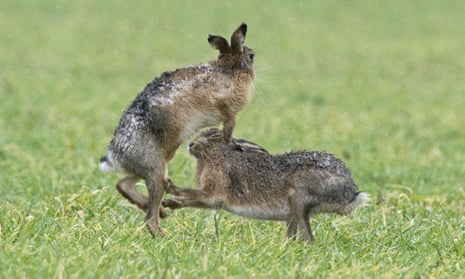It’s early, the sun has only just risen, yet already I can hear the drone of the bypass a few miles away as the rush hour traffic picks up. Every part of me is alert and awake. I can’t afford to lose focus for a moment for the horse I am on is fresh and quivering with energy.
Choosing our way carefully across the tussocky meadow I allow him to pick up into a trot. I breathe in the morning air and then, less than a metre from us, a rich brown, almost reddish, shape breaks for cover. We had all but stumbled on a resting brown hare (Lepus europaeus), crouched low and nearly invisible in its form. It darts off, strong back legs propelling it up the gentle slope.
We follow, with no hope of keeping up, until we reach the brow of the hill. There, the field stretches out before us and, as if on a stage, two hares are darting and dancing. They are not boxing, but frolicking together. Boxing hares were once thought to be males competing for females, like red deer rutting, but study has shown it is usually a female defending herself from an amorous male. In fact, it is the hare’s complex social hierarchies that determine which males mate with the females.
Forty two days after conception the leverets are born, fully furred and with their eyes open. Female hares can even be pregnant twice, simultaneously; they can conceive the next litter while still pregnant with the first.
The hares are too absorbed to notice that I am getting closer masked by the scent of horse. All at once they turn to face each other and their front paws go crazy.
It is less like boxing and more like children scrapping at intense speed. Their eyes are scrunched shut and the long black-tipped ears are held back. Fur flies, carried past me on the breeze.
One hare, presumably the female, drops to all fours and bounds right in front of us, closely pursued by the male. As we turn into the woodland I glance behind me. They have vanished.
Follow Country Diary on Twitter

Comments (…)
Sign in or create your Guardian account to join the discussion